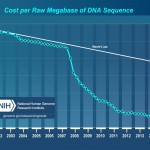
Peak Sequencing and 'Moore's Law' Deception
Our earlier article on Illumina’s surprise announcement received a number of informative comments. We like to discuss them here, but first it is important to explain the term ‘peak sequencing’ properly. That explanation requires us to discuss the relevance of using Moore’s law for sequencing.
Poser syndrome is quite common among humans. During 1999-2000, every Silly con valley startup wanted to be ‘the next yahoo’, and nobody wanted to imitate Steve Jobs. Steve Jobs was considered a failure (despite his success with Pixar), whereas yahoo was the future of internet. Fifteen year later, everyone wants to be ‘the next Steve Jobs’ and no yahoo fan is left.

However, the commonly uses Moore’s law in sequencing chart is the mother of all poser syndrome cases.
First, the chart is misleading, because the chart is not adjusted for quality of sequencing. In contrast, a transistor is a switch, be it in 5 micron technology or 14 nanometer technology. The semiconductor industry puts together all pieces to make sure the fundamental definition of MOSFET switch is not broken.
Second, sequencing cost is a meaningless measure within the big world of biomedical research and development, whereas transistor density is at the core of business proposition for many companies. In contrast, the bottom-line of hardly any company improves with Moore’s law like decrease in sequencing cost.
That brings us to ‘peak sequencing’. The importance of sequencing, and especially genome sequencing, was brought to the fore by propaganda leading up to the human genome project. That created a pent up demand for sequencing of other genomes, because many scientists saw ticket to high-profile papers by catching an interesting organism and sequencing its genome. There was no reason to expect the genome of an ant to be as social as an ant, or the genome of scarlet macaw to be as colorful scarlet macaw, but the pictures of interesting animals do make good journal covers. On top of that, NHGRI, the dysfunctional government agency that sponsored ENCODE, dreamed up of various make-believe uses of sequencing.
The entire enterprise failed, because the breadth of imagination of central planners could not keep up with the reduced cost of sequencing and other emergent technologies. The business case did not develop as anticipated, whereas the top journals made increasing demands on the genome projects, such as asking for two genomes, ten genomes, one thousand genomes and so on, before allocating them precious space. Scientists saw better opportunities elsewhere and moved on. Scientists are rational actors in this situation.
In our humble opinion, the peak of that shift came around late 2014-early
- Maybe this humorous post in parody site ‘The Science Web’ marked the peak.
90% of researchers sequencing things because they cant think of anything else to do
Cambridge, MA. 90% of genomics researchers are sequencing things because they exist in a complete intellectual vacuum and cant think of anything else to do, a recent survey suggests.
The survey asked the simple question: If you are currently involved in a genome sequencing project, can you identify any real reasons why?. 92% of the 10,000 scientists surveyed ticked no. In the comments box beneath the question, respondents had written if it moves, sequence it, I dont understand the question and you could sequence an ants scrotum and Genome Research would publish it.
Recent papers in genomics include those describing the genome of the cucumber, the genome of the centipede and the genome of the ferret. Some have suggested that scientists are simply following the alphabet, but Arthur MacDaniel of the Wide Institute denies this: Following the alphabet would imply that genomicists are following some kind of logic or rational; theyre not. Their motto is sequence first, think later but too often they only complete half of those tasks. These guys are frothing at the mouth for DNA. In fact, theyd sequence the froth and submit it to Nature if they could Arthur continued.
So, our ‘peak sequencing’ call does not mean researchers will not continue to do more sequencing in future, but this ‘sequence if you cant think of anything else to do’ madness has ended.
-————————————————-
Going back to specific comments -
Interesting enough Pacbio had a strong quarter, particularly in Europe. Id say its not so much the market slowing but that Illumina has some decent competition now.
In our understanding, those using Pacbio are not trying to get genome papers. Many of them realize that they already got their fifteen minutes of fame by publishing genome papers in visible journals, but cannot do much research with that genome split into countless contigs and scaffolds. Therefore, we do not expect a lot of big genome papers from those efforts, but the technology will continue to make inroads among serious scientists.
In my eyes Illumina unfortunately does not have any competition at the moment (perhaps the BGI-seq? but this exists only in China). PacBio has its niche, but this is small niche.
Illumina is however manipulating the market perhaps a bit too much with their X-series sequencers (e.g. selling the same costly reagents to companies/huge- institutes which buy 5 or 10 X-series sequencers at a third of the price that regular customers are paying.)
Why would smaller regular customers (which previously certainly made up the majority of instrument purchases) invest into new $100,000 machines if the monopolist is making arbitrary reagent pricing decisions and makes up arbitrary limitations on what people are allowed to sequence or not (and then changes these rules annually)? Due to its monopoly Illumina is in a position to arbitrarily manipulate the market and they are doing so thus purchasing a new pricey instrument becomes too risky for small institutes and Illuminas manipulations are backfiring.
Illumina’s success since 2008 is due to confluence of two factors -
(i) pent up demand for mindless sequencing due to NIH/NHGRI propaganda since human genome project, and top journals giving space to publication of genomes, just because the organisms are interesting.
(ii) Obama stimulus grant (American Recovery and Reinvestment Act of 2009) and various similar post-2008 crash spending all over the world. Illumina happened to be in the right place at right time.
With tightening budgets and lack of free money, the scientists are getting smarter as highlighted by your comment (“Why would smaller regular customers invest into new $100,000 machines..”). Given that the scientists are in the business of publishing most interesting papers with the least effort, sequencing may not be the avenue they choose.